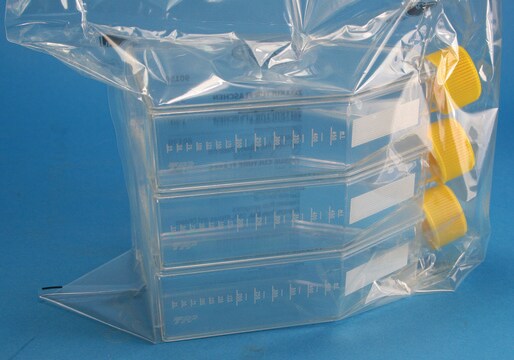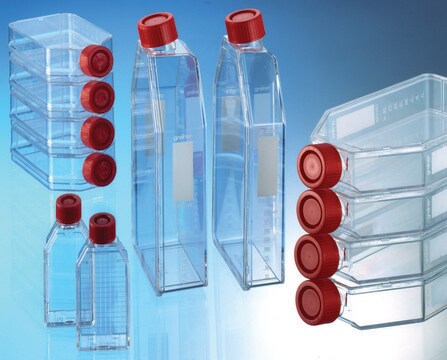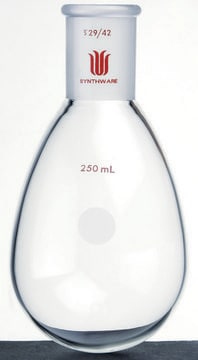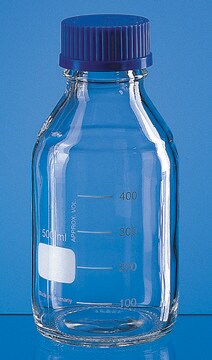Z707562
TPP® tissue culture flasks
Synonim(y):
T300 flask, cell culture flask, tissue culture flask
About This Item
Polecane produkty
Materiały
angled neck
polystyrene
screw top cap
sterylność
sterile
sterile
Właściwości
with cap (filtered)
opakowanie
case of 18 ea
case of 18
pack of 3
producent / nazwa handlowa
TPP 90301
pojemność
410 mL
zewnętrzne dł. × szer. × wys.
270 mm × 170 mm × 45 mm
powierzchnia
300 cm2 , growth surface (cm2)
pojemność robocza
30-40 mL
przydatność
suitable for (cell culture; tissue culture)
typ wiązania
Tissue Culture (TC)-treated surface
Szukasz podobnych produktów? Odwiedź Przewodnik dotyczący porównywania produktów
Opis ogólny
This excellent accessibility is due to the large neck opening and the favorable angle of inclination. The angled neck also reduces the chance of accidental spills and permits "dribble-free" pouring.
When the vented screw cap is tightened to the end position, the closed tissue culture flask is liquid and gas tight. By simply unscrewing the cap one quarter of a turn, the flask is in the "VENT" position, with the inside of the flask being aerated through a defined gap opening. This guarantees that the gas exchange with the environment and the possible risk of contamination are kept to a minimum. In addition, the special flat thread profile of the caps stops excess tightening and thus allows the caps to be re-used multiple times.
The TPP filter cap has a welded membrane in the cap cavity to offer free gas exchange without gas flow alteration. For optimal flask breathing, all membranes are proportionally dimensioned to each cap size. The microporous hydrophobic membrane (cytotoxic free) itself is constructed of 2 layers of membrane material based on a white acrylic copolymer over nylon support. With an airflow rate of 4.5 (LPM/3.7cm2/13.5psi), the gas exchange properties of the filtered flasks are comparable to that of the standard cap flasks.
Informacje prawne
Certyfikaty analizy (CoA)
Poszukaj Certyfikaty analizy (CoA), wpisując numer partii/serii produktów. Numery serii i partii można znaleźć na etykiecie produktu po słowach „seria” lub „partia”.
Masz już ten produkt?
Dokumenty związane z niedawno zakupionymi produktami zostały zamieszczone w Bibliotece dokumentów.
Nasz zespół naukowców ma doświadczenie we wszystkich obszarach badań, w tym w naukach przyrodniczych, materiałoznawstwie, syntezie chemicznej, chromatografii, analityce i wielu innych dziedzinach.
Skontaktuj się z zespołem ds. pomocy technicznej




